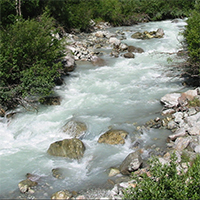Estimating aquatic invertebrate diversity in the southern Alps using data from Biodiversity Days

Submitted: 11 December 2020
Accepted: 26 April 2021
Published: 21 June 2021
Accepted: 26 April 2021
Abstract Views: 1058
PDF: 366
Supplementary: 97
HTML: 17
Supplementary: 97
HTML: 17
Publisher's note
All claims expressed in this article are solely those of the authors and do not necessarily represent those of their affiliated organizations, or those of the publisher, the editors and the reviewers. Any product that may be evaluated in this article or claim that may be made by its manufacturer is not guaranteed or endorsed by the publisher.
All claims expressed in this article are solely those of the authors and do not necessarily represent those of their affiliated organizations, or those of the publisher, the editors and the reviewers. Any product that may be evaluated in this article or claim that may be made by its manufacturer is not guaranteed or endorsed by the publisher.
Similar Articles
- Kay Van Damme, Eugeniya I. Bekker, Alexey A. Kotov, Endemism in the Cladocera (Crustacea: Branchiopoda) of Southern Africa , Journal of Limnology: Vol. 72 No. 3 (2013)
- Stefano Fenoglio, Tiziano Bo, Massimo Cammarata, Manuel J. López-Rodríguez, José M. Tierno de Figueroa, Seasonal variation of allochthonous and autochthonous energy inputs in an alpine stream , Journal of Limnology: Vol. 74 No. 2 (2015)
- Mohammed Kajee, Helen F. Dallas, Aneri Swanepoel, Charles L. Griffiths, Jeremy M. Shelton, The Freshwater Biodiversity Information System (FBIS) fish data: a georeferenced dataset of freshwater fishes occurring in South Africa , Journal of Limnology: Vol. 82 No. s1 (2023): Georeferenced freshwater biodiversity data
- Hugh B. Feeley, Stephen Davis, Michael Bruen, Sean Blacklocke, Mary Kelly-Quinn, The impact of a catastrophic storm event on benthic macroinvertebrate communities in upland headwater streams and potential implications for ecological diversity and assessment of ecological status , Journal of Limnology: Vol. 71 No. 2 (2012)
- Luciana Falci Theza Rodrigues, Beatriz F. Jabour Vescovi Rosa, Haroldo Lobo, Alex Campos Divino, Roberto da Gama Alves, Diversity and distribution of oligochaetes in tropical forested streams, southeastern Brazil , Journal of Limnology: Vol. 74 No. 3 (2015)
- Doris Gesierich, Eugen Rott, Is diatom richness responding to catchment glaciation? A case study from Canadian headwater streams , Journal of Limnology: Vol. 71 No. 1 (2012)
- Ruben Ladrera, Miguel Cañedo-Argüelles, Narcís Prat, Impact of potash mining in streams: the Llobregat basin (northeast Spain) as a case study , Journal of Limnology: Vol. 76 No. 2 (2017)
- Jennifer K. Hellmann, Jeffrey S. Erikson, Simon A. Queenborough, Evaluating macroinvertebrate community shifts in the confluence of freestone and limestone streams , Journal of Limnology: Vol. 74 No. 1 (2015)
- Anna C.F. Aguiar, Vinicius Neres-Lima, Timothy P. Moulton, Relationships of shredders, leaf processing and organic matter along a canopy cover gradient in tropical streams , Journal of Limnology: Vol. 77 No. 1 (2018)
- Daniela Ghia, Gianluca Fea, Aurora Conti, Roberto Sacchi, Pietro Angelo Nardi, Estimating age composition in Alpine native populations of Austropotamobius pallipes complex , Journal of Limnology: Vol. 74 No. 3 (2015)
You may also start an advanced similarity search for this article.

 https://doi.org/10.4081/jlimnol.2021.1999
https://doi.org/10.4081/jlimnol.2021.1999





